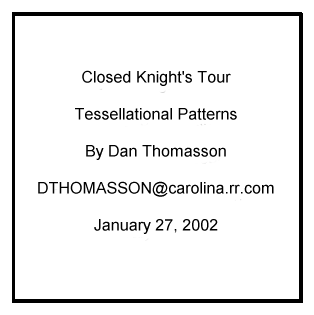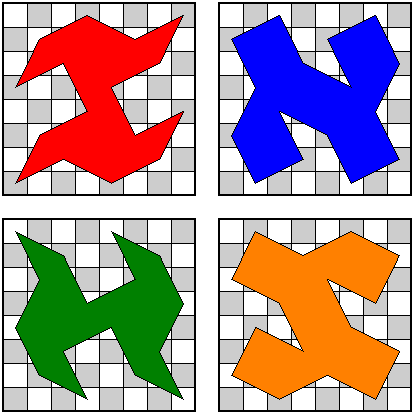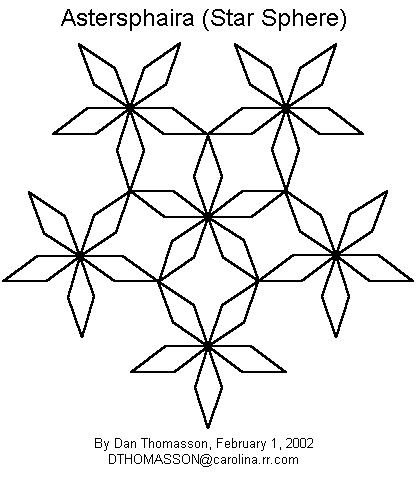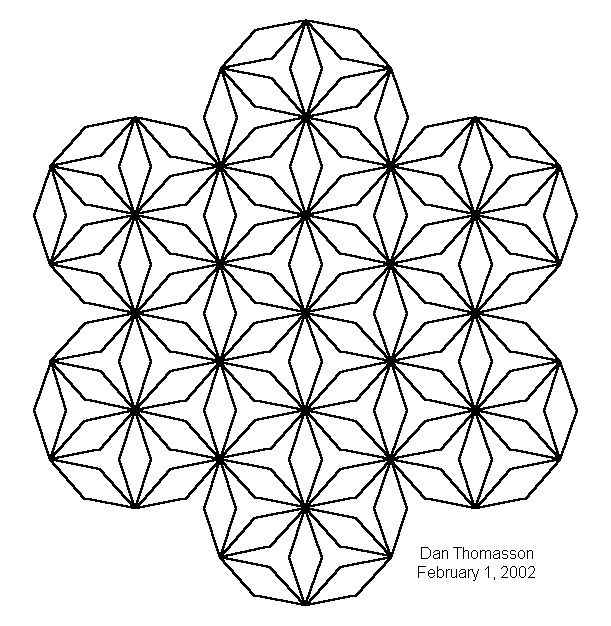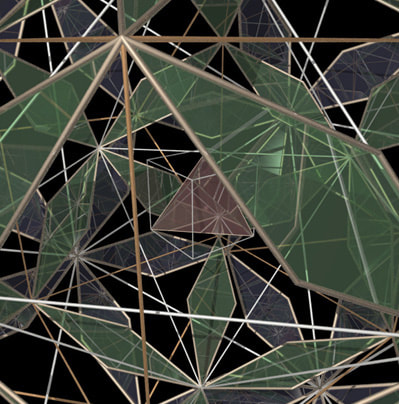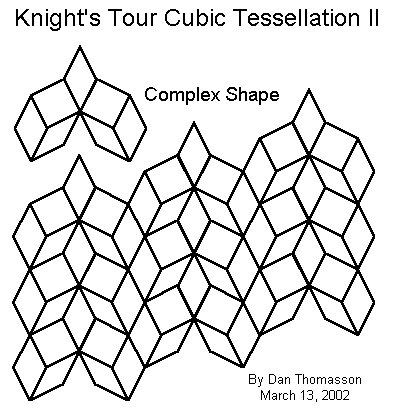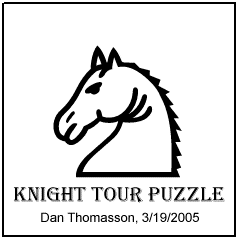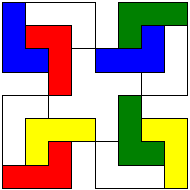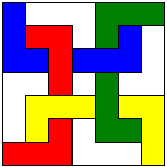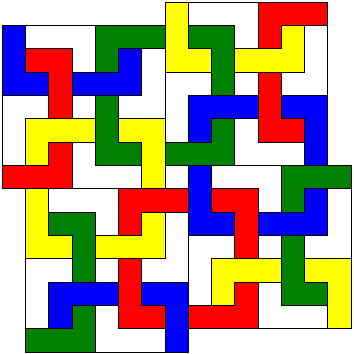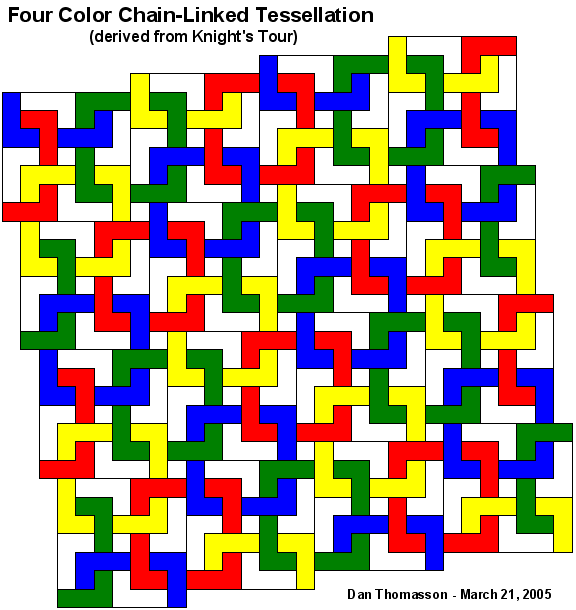Knight's Tour Tessellations
In the above Closed Knight's Tour animation, notice the basic patterns being made by each consecutive 16 moves of the Knight. By putting each pattern on a separate chess board,
closing the open pattern to make a geometric shape, and filling in the pattern with the same color as the line path's color, there now exists four pieces that can be connected into one piece,
in such a way that it can be tessellated. Tessellation means the complete covering or tiling of a plane or space with a non-overlapping shape.
Here is a tessellation created from the previous image, that if properly cropped, can be used as a webpage background, wallpaper, picture, or floor tiling.
Michiel de Bondt used the above tessellation patterns to make a very nice web-page background for http://www.math.ru.nl/lo_shu_tot_sudoku/. As you can see, Arno van den Essen used the same tessellation background for the cover of his book: Magische Vierkanten - Lo Shu Tot Sudoku.
Michiel and Arno were both mathematicians in the Netherlands at the Radboud Universiteit Nijmegen Institute for Mathematics, Astrophysics and Particle Physics. Arno states the following about his Dutch book:
Knight's Tour Tessellations can be used to create beautiful symmetrical patterns. A few of the many possibilities are shown below.
- On pages 100-103 I describe your work on tessellations and mention on page 101 that also the tessellations on the cover are created by you.
- On page 227 I refer to your internet site at borderschess.org/KnightTour.htm (site is closed). The translation of the Dutch text is: "A beautiful site of Dan Thomasson on Knight's tours, containing very nice and artistic applications."
- Of course, on page 11, I thank you (and some other people) for their help!
Knight's Tour Tessellations can be used to create beautiful symmetrical patterns. A few of the many possibilities are shown below.
Print out two copies of the above Astersphaira (Star Sphere) on 60 lb weight paper or higher and connect them together to make the following tessellated paper sphere.
Paul Bourke converted my paper Astersphaira into excellent computer generated graphics art along with my other ideas for Hexastersphaira, Polarsphaira, and additional combinations of each one.
Astersphaira (Star Sphere) represents the surrounding stars of the Universe. It is a 3-d tiling of 12 stars. Each of the five limbs of the stars were created by the diamond patterns made from the Knight's move on the chess board. If a boarder-line was drawn around the outer perimeter of each star, 12 pentagon patterns would appear, thus making a Dodecahedron (12-sided figure). Historically the Dodecahedron symbolizes the Universe.
At the same time, when looking at the Astersphaira, one may notice 20 triangular shapes made with 3 diamond patterns each. This construction would then be called an Icosahedron. Both the Dodecahedron and the Icosahedron are harmoniously intertwined. The Icosahedron has 20 faces and 12 vertices while the Dodecahedron has 12 faces and 20 vertices, an exact reciprocal of each other.
What do you get when you cross a Dodecahedron with an Icosahedron? You get the following Icosidodecahedron.
Another tessellation pattern made by the diamond shape polygons of Knight's moves on the chessboard can be called a Hexastersphaira (Six Star Sphere).
Paul Bourke used my ideas to make the following image of the Hexastersphaira.
Did you notice when looking at the tiled sphere that both the Icosidodecahedron and the Hexastersphaira graphics are actually identical. By replacing the perimeter edges in the Icosidodecahedron with star limbs, the Hexastersphaira takes its form.
Polarsphaira (Polar Sphere) represents the polarity of the earth and earth itself. It is a 3-d tiling of six compass shapes. Each compass contains four rhombus polygons (representing North, South, East, and West) made from the Knight's move on the chessboard. If a boarder-line was drawn around the outer perimeter of each compass, 6 square patterns would appear, thus making a Cube or Hexahedron (6-sided figure). Historically, the Hexahedron symbolizes the Earth.
At the same time, when looking at the Polarsphaira, one may notice 8 triangular shapes made with 3 rhombus patterns each. This construction would then be called an Octahedron. Both the Hexahedron and the Octahedron are harmoniously intertwined, as is the Dodecahedron and Icosahedron mentioned earlier. The Hexahedron has 6 faces and 8 vertices while the Octahedron has 8 faces and 6 vertices, an exact reciprocal of each other.
The next Polarsphaira image is similar to the Rhombus Hexahedron/Octahedron but using the diamond shape polygons of the Knight's move.
Four of the five platonic solids are represented by the Knight's move on the chess board. The perimeters of these platonic solids can all be seen below in what I call "Creation Designed."
The only other polygon made by the Knight is the square which can be used to make a cube. The fifth platonic solid, not yet mentioned, is the Tetrahedron which is contained within the cube. The Tetrahedron represents the concept of system. It is the underlying basic structure of the earth, sun, stars, and life itself. In reality, approximately 90% of all the earth's crust is made from silicate minerals (a group of rock forming minerals) which are based on the fundamental structural unit: a Tetrahedron.
Isn't it interesting about the dichotomy of creation. The Astersphaira (Star Sphere) contains the Dodecahedron and Icosahedron. The Polarsphaira (Polar Sphere) contains the Hexahedron and Octahedron. Notice that those shapes can be easily created from spheres when using the 3-d tiling of the Knight's move patterns. I like using the model as a teaching aid to show the relationships of the platonic solids. The cube at the center of the Polarsphaira contains the Tetrahedron but it is not visible to the eye. The ornament can have several different stories associated with it such as the following:
I made up the words Astersphaira, Polarsphaira, and Hexastersphaira using mostly the Greek language to give homage to Greek geometry. Astersphaira is from the Greek Aster (Star) + sphaira (sphere). Polarsphaira is from the new Latin Polaris (Polar) + sphaira (sphere). Hexastersphaira is from the Greek Hex (Six) + aster (star) + sphaira (sphere).
- The Christian Trinity of the Father (Astersphaira), the Son (Polarsphaira), and the Holy Ghost (Tetrahedron)
- The Biblical book of Genesis 1:1 - In the beginning, God created the heavens (Astersphaira) and the earth (Polarsphaira)
- The Hindu mythological male Purusha (Icosahedron) and female Prakriti (Dodecahedron) giving birth to Purusha Junior
- The Chinese Yen and Yang, nature's two channels of electric-flows which bring about changes in the Universe
- The Chemistry or Physics "polaron", a conducting electron in an ionic crystal together with the induced polarization of the surrounding lattice
I made up the words Astersphaira, Polarsphaira, and Hexastersphaira using mostly the Greek language to give homage to Greek geometry. Astersphaira is from the Greek Aster (Star) + sphaira (sphere). Polarsphaira is from the new Latin Polaris (Polar) + sphaira (sphere). Hexastersphaira is from the Greek Hex (Six) + aster (star) + sphaira (sphere).
The following tessellation patterns encompass all the basic shapes (square, diamond, and rhombus) made by the Knight's tour moves. They show two different geometrical cubic staircase patterns.
While playing around with Knight's moves on the chessboard, I ended up with an interesting symmetrical pattern that could be turned into a very nice Four-Color Chain-Linked Tessellation. Enjoy the following animation.
After making the above animation, I connected the four symmetrical patterns from the 8x8 square to make a 7x7 square tessellation piece. I then divided each individual pattern within the square into three smaller shapes representing the 2-1 "L" shaped move of the Knight. I changed the colors of the red squares within the four symmetrical patterns of the Knight's Tour to include blue, green, yellow, and white. As you will see, the white patterns become the background, and there are no white colored links. All the white shapes should be transparent, thus only showing the red, green, blue, and yellow links. The center square of the 7x7 tessellation piece is actually a gap, as can be seen in the animation.
Four copies of the 7x7 square shown above, can be connected together in such a way as to make a single larger tessellation piece. The center white square of the four combined pieces is also a gap. Therefore, the pattern is not a true regular tessellation, but a complex tessellation where small gaps do exist. None-the-less, the tiling of the tessellation piece makes for an interesting interlocking chain of red, green, blue, and yellow square links.
Now we can replicate the larger tessellation piece, and tile the pieces into a work of art that I call the Four-Color Chain-Linked Tessellation (derived from Knight's Tour):
